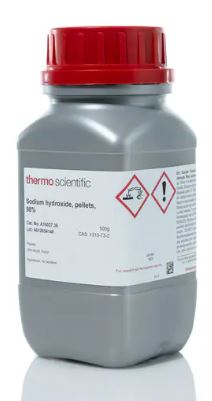SODIUM HYDROXIDE (NaOH), pure, pellets, 1 kg
Valid Article
SODIUM HYDROXIDE (NaOH)
Reserved for TB culture programmes.
Definition
Reagent used to prepare decontaminant solution to be added to samples suspected to contain mycobacteria, before inoculation on selective media.
Specifications
- CAS N°: 1310-73-2
- Formula: NaOH
- Purity: >98%
- Caustic soda /soda lye
- White pellets (anhydrous)
Packaging & Labelling
1 kg in plastic bottle
Transport Dangerous Goods
- UN1823
- Class: 8
- Packing group: II
- Proper shipping name: Sodium hydroxide, solid
Instructions for use
NaOH is highly hygroscopic, weigh it rapidly while preparing the solution.
Use cool containers to mix with water, to minimize heat build-up.
To prepare the decontaminant solution, add the 4% NaOH solution to the sodium citrate solution. Autoclave the mixture, then add with N-acetyl-L-cysteine just before use.
Follow carefully recommendations concerning reagent concentration and the timing of digestion step, as the reagent is toxic also for Mycobacteria.
Storage
- Keep container tightly closed in a dry and well-ventilated place
- Store the reagent at refrigerator temperature, in a screw-cap flask, protected from air
- At concentration higher than required for mycobacteriology (2%), store the solution in plastic containers.
- Shelf life: 2 years
Classification EC Regulation N° 1272/2008
Check SDS from manufacturer
- Corrosive to metals: Category 1, H290
- Skin corrosion: Category 1A, H314
- (Serious eye damage/Eye irritation, Category 1, H318)
Signal Word
Danger
| H290 | May be corrosive to metals. |
| H314 | Causes severe skin burns and eye damage. |
| P260 | Do not breathe dust/fume/gas/mist/vapours/spray. |
| P280 | Wear protective gloves/protective clothing/eye protection/face protection |
| P301 + P330 + P331 | IF SWALLOWED: rinse mouth. Do NOT induce vomiting |
| P302 + P352 | IF ON SKIN: wash with plenty of soap and water |
| P304 + P340 | IF INHALED: Remove to fresh air and keep at rest in a position comfortable for breathing. |
| P305 + P351 + P338 | IF IN EYES: rinse cautiously with water for several minutes. If the victim wears contact lenses, remove them if possible. Keep rinsing |
| P308 + P313 | IF exposed or concerned: Get medical advice/attention. |
MSF requirements
NaOH solution with sodium citrate solution and N-acetyl- L-cysteine is recommended for decontamination of samples investigated for mycobacteria.

